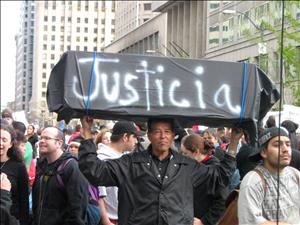On May 1, 2006, thousands of people march the streets of Seattle and Yakima in support of immigrants' rights in some of the largest marches in recent history. The march, characterized as "the day without immigrants" was coordinated by immigrants' rights proponents from various sectors of the community, including faith-based organizations, organized labor, human rights groups, and students at college and high school levels. The event coincided with International Worker's Day as a symbolic gesture of solidarity with immigrant workers and their families throughout the United States.
Silent March in Seattle
The march in Seattle had a distinct flavor as organizers parted from what other cities did and coordinated a silent march from St. Mary's Church in the Central District to the Federal Building in downtown Seattle. Many of the participants, who donned black shirts, did so as a visually distinctive gesture that brought attention to the death toll of people who sacrificed their lives in attempting to cross the U.S.-Mexico border. The silent procession culminated in a massive rally in downtown Seattle that called for collective action in opposing the proposed draconian legislation at the national level, and an appeal to peace and the recognition of civil, labor and human rights of all who come to the United States as immigrants.
The legislation, House Resolution 4437, which was passed in the House, but stalled in the Senate, was at the center of the debate. Though odds are the legislation "as is" will die, different sections of it, are being passed individually, such as the new legislation signed by the President that will add an additional 700 miles of fencing to the border. Included in the original text of the resolution was the idea of deporting the immigrant parents of U.S. citizens (instantly tearing apart families and making anyone under 18 a ward of the state), and the idea of incarcerating for up to three years in prison and handing fines to anyone who "aids" undocumented immigrants. (This meant the instant criminalization of schools, churches, hospitals, community organizations, and families of anyone who is undocumented for providing them with assistance.)
Though many of the organizers and participants in the May 1 march in Seattle were of Latin American descent, the march was as diverse as the immigrant community itself, the issue of immigrants' rights being one that impacts people who emigrate from Asia, Africa, Europe, as well as the Americas.
Hillary Stern, an organizer with CASA Latina, an organization that dispatches day laborers, estimated the size of the crowd at approximately 65,000 people. Among the groups were Comite Pro-Amnistia Y Justicia Social, Washington State Jobs With Justice, the Northwest Immigrants Rights Project, and the M.E.Ch.A chapters from throughout Western Washington (Skagit Valley College, University of Washington, Western Washington University, Evergreen State College). As in a previous march that took place in Seattle on April 10, the demonstration was orderly as no arrests were registered amongst the participants.
Activists Make Impact in Yakima
The city of Yakima also witnessed perhaps one of the largest demonstrations in its history. Student activists and community organizers, along with labor and religious groups, helped draw an estimated 15,000 people to the streets of Yakima. The demonstration had a profound impact in the Yakima Valley, which is the hub of much of Washington State's Latino community, as various businesses closed down shop for the day.
The "Day Without Immigrants" on May 1, 2006, proved to be one of the largest mass demonstrations in U.S. history. Other cities registered massive marches including Los Angeles (500,000), Chicago (400,000), Denver (75,000), Houston (15,000), San Jose (50,000), San Francisco (30,000 plus), as well as various other communities from New York City to small towns in the Midwest

